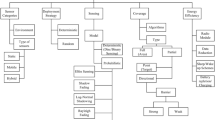Abstract
Nowadays, the recent developments in the field of wireless sensor networks (WSNs) have initiated new applications of WSNs which can be used in many fields, such as military, environment, health, home and industry. One of the emerged wireless sensor networks topologies are linear wireless sensor networks (LWSNs). They have been rising as a great focus area of research. Such wireless sensor networks have a large number of applications such as border monitoring, railway track monitoring, structural health monitoring of bridges, health care and machines surveillance. LWSNs are widely applied in oil and gas pipelines infrastructure monitoring applications to enable the automatic measurement, analyses, storage and transmission of real-time data. Minimization of energy consumption of LWSNs is crucial for their proper usage. Using two different system models, this research investigates the minimization of LWSNs energy consumption using optimal node placement strategies compared to simple equal-distance placement scheme.







Similar content being viewed by others
References
Varshney, S., Kumar, C., & Swaroop, A. (2015). Linear sensor networks: Applications, issues and major research trends. In International conference on computing, communication & automation (ICCCA).
Imran, C., Aldukhail, M., Almezeini, N., & Alnuem, M. (2016). Potential applications of linear wireless sensor networks: A survey. International Journal of Computer Networks and Communications Security, 4(6), 183–200.
La Rosa, R., Livreri, P., Trigona, C., Di Donato, L., & Sorbello, G. (2019). Strategies and techniques for powering wireless sensor nodes through energy harvesting and wireless power transfer. Sensors., 19, 2660.
Qiu, L., Salcic, Z., & Wang, K. I. (2019). Adaptive Duty Cycle MAC Protocol of Low Energy WSN for Monitoring Underground Pipelines. 2019 IEEE 17th international conference on industrial informatics (INDIN), Helsinki, Finland (pp. 41-44).
Aalsalem, M. Y., Khan, W. Z., Gharibi, W., Khan, M. K., & Arshad, Q. (2018). Wireless sensor networks in oil and gas industry: Recent advances, taxonomy, requirements, and open challenges. Journal of Network and Computer Applications, 113, 87–97.
Kara, A., Al Imran, M. A., & Karadag, K. (2019). Linear wireless sensor networks for cathodic protection monitoring of pipelines. In 2019 International conference on mechatronics, robotics and systems engineering (MoRSE), Bali, Indonesia (pp. 233–236).
Irannejad, M., & Iraninejad, M. (2014). Remote monitoring of oil pipelines cathodic protection system via GSM and its application to SCADA system. International Journal of Science and Research (IJSR), 3(5), 1619–1622.
Abate, F., Caro, D. D., Leo, G. D., Pietrosanto A., & Paciello, V. (2019). Smart meters communication using Gas pipelines as channel: feasibility study. In 2019 IEEE international instrumentation and measurement technology conference (I2MTC), Auckland, New Zealand (pp. 1-6).
Liu, P., Huang, Z., & Duan, S. (2015). Optimization for remote monitoring terrestrial petroleum pipeline cathode protection system using graded network. International Journal of Smart Home, 9(6), 51–64.
Gundampati, K. (2019). Wireless sensor network (WSN) platform for railway condition monitoring. Master’s thesis, University of Huddersfield.
Noel, A. B., Abdaoui, A., Elfouly, T., Ahmed, M. H., Badawy, A., & Shehata, M. S. (2017). Structural health monitoring using wireless sensor networks: A comprehensive survey. IEEE Communications Surveys & Tutorials, 19(3), 1403–1423.
Li, R., Ma, W., Huang, N., & Kang, R. (2017). Deployment-based lifetime optimization for linear wireless sensor networks considering both retransmission and discrete power control. PLoS ONE, 12(11), e0188519.
Liang, W., Ma, C., Zheng, M., & Luo, L. (2019). Relay node placement in wireless sensor networks: From theory to practice. IEEE Transactions on Mobile Computing. https://doi.org/10.1109/TMC.2019.2962674.
Cheng, P., Chuah, C., & Liu, X. (2004). Energy-aware node placement in wireless sensor networks. Globecom: IEEE Communications Society.
Li, H., & Shunjie, X. (2010). Energy-efficient node placement in linear wireless sensor networks. In International conference on measuring technology and mechatronics automation (ICMTMA).
Sazak, N., & Ertug, M. (2017). The effect of node deployment scheme on LWSN lifetime for railway monitoring applications. In 2017 IEEE workshop on environmental, energy, and structural monitoring systems (EESMS) (pp. 1–4).
Wang, Z., Zhao, X., & Qian, X. (2011). An Energy Balanced Deployment for Linear Wireless Sensor Networks. International Conference on Computer Science and Network Technology.
Ali, S., & Qaisar, S. B. (2014). A reliable connectivity based node placement strategy in linear and hierarchical wireless sensor networks. In IEEE 25th annual international symposium on personal, indoor, and mobile radio communication (PIMRC) (pp.763–767).
Heinzelman, W., Chandrakasan, A., & Balakrishnan, H. (2002). An application-specific protocol architecture for wireless microsensor networks. IEEE Transactions on Wireless Communications, 1(4), 660–670.
Sinha, K., Sinha, B., & Datta, D. (2011). An energy-efficient communication scheme for wireless networks: A redundant radix-based approach. IEEE Transactions on Wireless Communications, 10(2), 550–559.
Rappaport, T. (1996). Wireless communications: Principles practice. New Jersey: Prentice-Hall Inc.
Kurt, S., & Tavli, B. (2017). Path loss modeling for wireless sensor networks: Review of models and comparative evaluations. IEEE Antennas and Propagation Magazine, 59(1), 18–37.
Author information
Authors and Affiliations
Corresponding author
Additional information
Publisher's Note
Springer Nature remains neutral with regard to jurisdictional claims in published maps and institutional affiliations.
Rights and permissions
About this article
Cite this article
Hussein, A., Elnakib, A. & Kishk, S. Linear Wireless Sensor Networks Energy Minimization Using Optimal Placement Strategies of Nodes. Wireless Pers Commun 114, 2841–2854 (2020). https://doi.org/10.1007/s11277-020-07506-9
Published:
Issue Date:
DOI: https://doi.org/10.1007/s11277-020-07506-9




